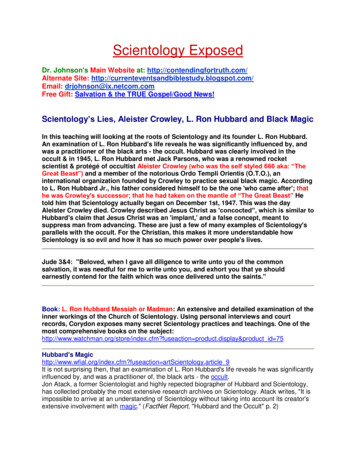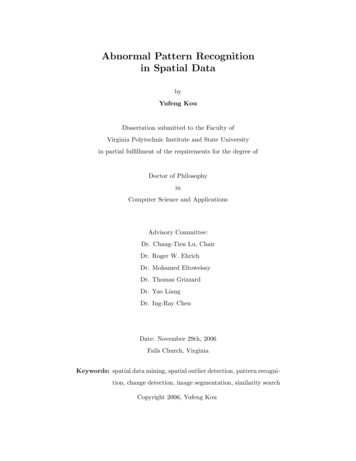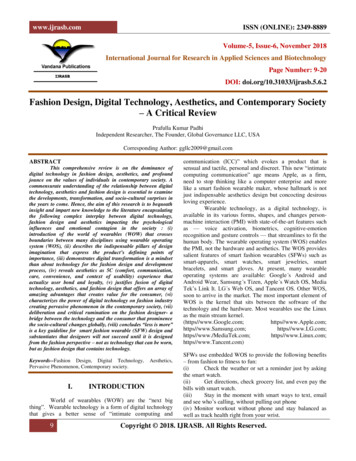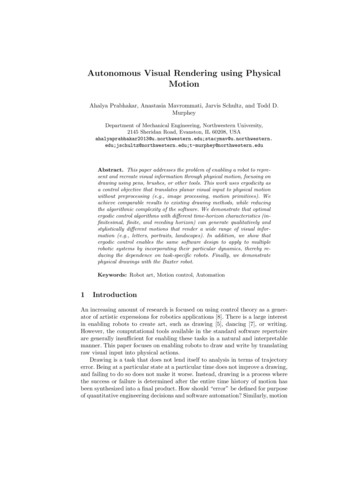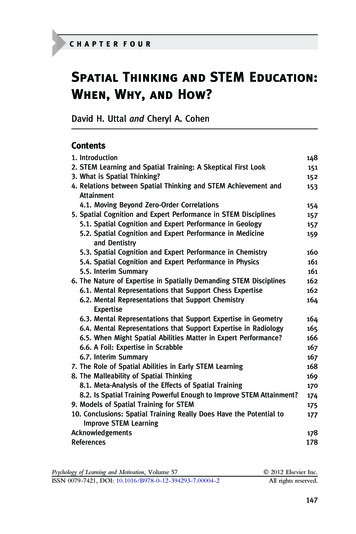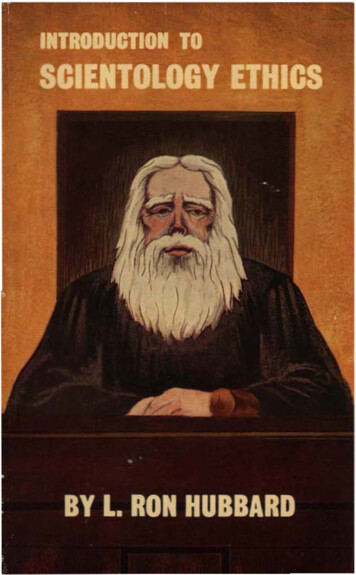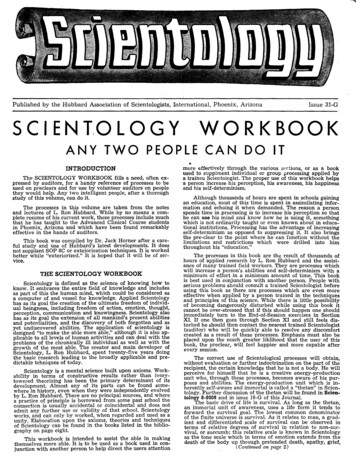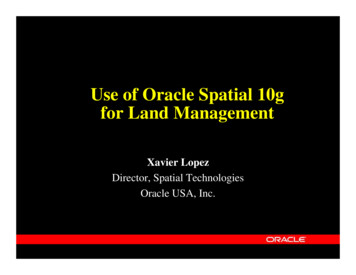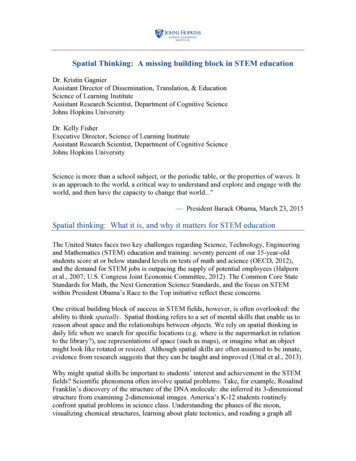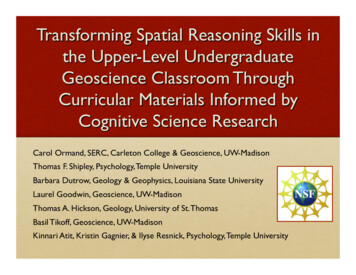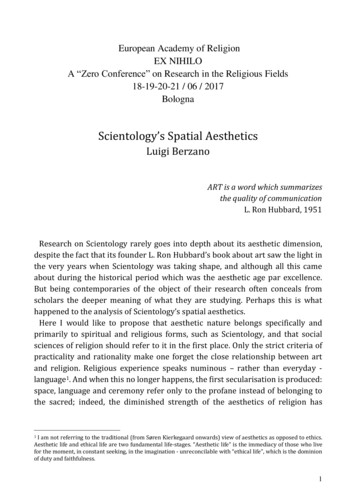
Transcription
European Academy of ReligionEX NIHILOA “Zero Conference” on Research in the Religious Fields18-19-20-21 / 06 / 2017BolognaScientology’s Spatial AestheticsLuigi BerzanoART is a word which summarizesthe quality of communicationL. Ron Hubbard, 1951Research on Scientology rarely goes into depth about its aesthetic dimension,despite the fact that its founder L. Ron Hubbard’s book about art saw the light inthe very years when Scientology was taking shape, and although all this cameabout during the historical period which was the aesthetic age par excellence.But being contemporaries of the object of their research often conceals fromscholars the deeper meaning of what they are studying. Perhaps this is whathappened to the analysis of Scientology’s spatial aesthetics.Here I would like to propose that aesthetic nature belongs specifically andprimarily to spiritual and religious forms, such as Scientology, and that socialsciences of religion should refer to it in the first place. Only the strict criteria ofpracticality and rationality make one forget the close relationship between artand religion. Religious experience speaks numinous – rather than everyday language1. And when this no longer happens, the first secularisation is produced:space, language and ceremony refer only to the profane instead of belonging tothe sacred; indeed, the diminished strength of the aesthetics of religion hasI am not referring to the traditional (from Søren Kierkegaard onwards) view of aesthetics as opposed to ethics.Aesthetic life and ethical life are two fundamental life-stages. “Aesthetic life” is the immediacy of those who livefor the moment, in constant seeking, in the imagination - unreconcilable with “ethical life”, which is the dominionof duty and faithfulness.11
encouraged the “religion of art” which – according to theories and research – insecular societies constitute a new, substitute, religion.Today’s development of aesthetics goes well beyond classical theories of thephilosophy of the beautiful, venturing into fresh fields with daring innovativeexperiments. In addition, aesthetics has made its appearance in such unexpectedareas as consumption, and territorial and community development. Economicshas adopted aesthetics in its events, shows and displays. By now aesthetics ispresent – even if in latent forms – in biopolitics, mass media studies,epistemology and communication theory.So many salvation and perfection utopias have emerged all over the place inthe symbolic sphere of religions and spiritual movements that it is possible tosee the New Age as the latest global movement of emotions after the classicalsocial movements of industrial society. Even among religious and theologicalstudies we can find authors and research dealing with aesthetics – redefined,however, more as a philosophy of emotions than reflection on the essence of thebeautiful or the spiritual. The result is impoverishment not only of aesthetics butalso of religion itself: religion is not just ethics and beliefs – it is above allmobilisation of affection, feelings, sensitivity and what the Greeks calledaisthesis.In order to propose a research model for Scientology’s aesthetics it would beuseful to examine its thinking and experience vis-à-vis the classical aesthetictradition. Kant (Critique of Judgement) and Hegel (Aesthetics) are still offundamental importance: upon them are constructed the four conceptual pillarsof life, form, knowledge and action2. The flowering of these four areas took placeas a result of new contexts and historical conditions of 1960s transformations:the aesthetics of life acquired a political significance; the aesthetics of formassumed mediatic value; cognitive aesthetics cultivated sceptical worth; andpragmatic aesthetics developed communicative importance. Therefore doingresearch in these fields means dealing with, respectively, politics, the media,scepticism and communication. To these major areas can be added those offeeling and culture. The term aesthetics has its origin in feeling – the world ofsensitivity, affectivity and excitement – to the extent that the most importantrecent contributions have come from psychologists, philosophers, theologiansand writers. It is not possible to understand L. Ron Hubbard’s artistic2M. Perniola, L’estetica contemporanea, il Mulino, 2011.2
contribution and philosophical writings on art without collocating them in thatmore general environment.1. Ron Hubbard’s “aesthetic mind”L. Ron Hubbard’s first writings on art come from 1943, but his most importantwork saw the light in 1951. There the author theorized that, over and abovenormal everyday thought, there exists an “aesthetic mind”, and it is that level ofmental activity which «deals with the nebulous field of art and creation». Theauthor reminds us of the work of Francis Bacon, the first to elaborate the idea ofcodification according to which every subject can be dealt with systematically onthe basis of its own rules.In a 1950 New Jersey debate with Donald H. Rogers in New Jersey, Hubbardclaimed that the definition of art should go beyond that of those days; it couldnot be incomplete and evasive the closer one got to it. Common notions of artdid not involve research into the human mind and spirit, upon which Hubbardwas working. On August 30, 1965, he published the HCOB3 “ART” (no 1. in theart series), where, in the section entitled The Fundamentals of Art, he proposes adefinition of art as a higher form of communication: ART is a word whichsummarizes the quality of communication. Thus art obeys the laws ofcommunication, and the excessive originality of many innovative artists «throwsthe audience into unfamiliarity and therefore disagreement». Perfection andaesthetics should not be reached at the expense of communication (HCOB,August 30, 1965). Here Hubbard observed that art is “the least codified ofhuman endeavours and the most misunderstood”. In the following months andyears, using the definition quoted above as his fixed point of departure, hecontinued to codify the field of art in detail, describing – among other things –art’s artistic presentation, its message, rhythm, colour and equipment. These areonly some of the subjects written about in Hubbard’s book ART, which has sincebecome a point of reference for the work of expert professionals. It is also thebasic text for the Hubbard Art Course designed for those who would like to comecloser to Scientology’s aesthetic concepts and methods.HCOB: Hubbard Communication Office Bulletin. The HCOBs are all written by L. Ron Hubbardwith red ink on white paper. They are collected in the Red Volumes and are autonomous workswith their own date and title. They can be part of thematic collections or books or reference packsfor study courses.33
According to Scientology, art is the quality of a particular wave involving all ofan individual’s 57 perceptions4. This product of communication vibrations canbe found in paintings, in music, sculpture, literature, theatre and in the buildingswe perceive and define as “beautiful”. Art is the specific vibration leading tosurvival in the physical universe which goes beyond the eight dynamicsindicated by Hubbard – the ninth survival dynamic preceding the tenth, which isethics. Both, being outside the physical universe, enter it by means of artisticcreation. (PDC second lecture)5. This ninth dynamic transcending the physicaluniverse explains the absence, in the history of art, of a definition of art andaesthetics based on artistic works, thus the effect (the artistic product) ratherthan studying its cause.2. The Church of Scientology’s spatial aestheticsHubbard’s elevated vision of art contrasts with the widespread assessmentthat Scientology Churches have stylistic characteristics which are exaggeratedlyNorth American: monumental buildings, impressive settings for meetings,They are the 57 human perceptions. “Scientology 0-8. The book of basics”, by L. RonHubbard, New Era Publications International, Copenhagen, 2007; page 166.5 PDC: Philadelphia Doctorate Course. The reference to the 9th and 10th Dynamics is contained inthe second lecture of the Course held on December 1, 1952 and titled “E-meter, demonstration”,published by Golden Era Productions, Los Angeles, California, 2003.The reference to the 9th and 10th dynamics in that lecture is in the context of a lecture on theHubbard Electrometer, specifically to ascertain the capacity of a person to create and destroy.People who can only create and not also capable to destroy are “crazy”, like those who are capableonly to destroy and never create.“ theoretical sanity of this individual depends on being able to create and destroy anything, notjust in terms of illusion ”It is, nevertheless, a philosophy of life impossible in this universe (create and destroy everything).Use it as philosophy of life lead to the insanity as, according to Hubbard, happened to Nietzche,who went crazy because of thinkingness rather than syphilis, “ and so will anybody go mad thattries to use that as a philosophy of life, for the good reason that it is too unlimited in the absence ofa knowledge of this universe to be executable. It’ can’t be executed.”If would exist a person capable to apply it as philosophy of life, that person would go out of bounds(unlimited). This person would be outside the known physical universe “ finds himself associatedwith a group and has actually what could be consider to be the Ninth Dynamic, which would beaesthetics, and the Tenth Dynamic, which would probably be ethics “I thank professor Fabrizio d’Agostini for these strict bibliographic indications and for the directionin the interpretation of the 9th and 10th Dynamics.44
enormous plasticized backdrops, wall-to-wall carpets, fiberglass, naturalisticpictures of subjects which are often fantastic or surreal, and large photographs –typically of Hubbard himself.Every Scientology church aims to give form and life to Hubbard’s vision, and tobe a place of worship, seeking and spiritual freedom; each once is thecornerstone of a new, better, world. This is why it tends towards majesticchurches. «Once cathedrals were built with the materials, and according to thestyles, of the age. Today there are new styles and technologies. They all reflectthe civilisation and sensibility of their time. So too do Scientology churches»6.Every Scientology building is set in time, with various criteria for itsconstruction and for thinking about its future; but, as one interviewee noted,there is no hubris about how long it will last. Of course the building will lastlonger than the life of its faithful, of whom it represents the last trace. Even thebuilders of Gothic cathedrals left some trace of themselves in time so that theirlives and message would be inscribed in stone for generations to come. EvenBiblical tradition does not condemn this desire to leave some trace of oneself.According to the Torah one’s name, symbolizing the role one plays in history,should not be linked to an object in space (one should not “make a name foroneself” but should rather be given it by others); it is a divine promise that it willbe kept alive throughout history.No space in a church is just any old space in the world’s enormous extent andvacuum: it is a point of reference, almost as if it were the “world-centre”, inaccordance with all religions’ visions where each sacred building is meant to bean imago mundi and aims to reflect the world in itself7. This symbolic value canbe seen in all sacred architecture: a foray into the world of transcendence tointroduce new elements into the natural world. But sacred buildings add a thirdactor to the man-nature relationship: mystery, the transcendent, God.Building a church or choosing a building and converting it into a church – asoften happens with Scientology Churches – possesses the same anthropologicaland existential wealth as dwelling. In his volume Bauen, Wohnen, Denken(Building, Living, Thinking), Martin Heidegger traces the etymology of theGerman verb bauen (to build) back to the meaning “I am”8. Building, living andbeing are three facets of the same human reality and experience. Living,Interview IV. The five qualitative interviews were carried out for this talk by members of the Church ofScientology of Turin.7 For the concepts of “imago mundi” and “cosmogony” see Iliade M., Il sacro e il profano, pp. 41-45; 50-53.8 Martin Heidegger, quoted by David Banon, Déborah Derhy, Lo spirito dell’architettura. Dialogo o Babele?Edizioni Qiqajon, 2014, p. 16.65
inhabiting or dwelling mean the way people are on earth. Being a human meansliving and existing on earth as a mortal creature. The essence of building is toprepare a dwelling-space for gods and mortals, heaven and earth. Even aScientology Church, apart from its architectural environment, is an image ofartistic, spiritual, human action: the sacrality therein indicates what is “more”deriving from a multiple set of elements such as painting, music, rituals and –above all – architecture.Many analyses have been carried out in relation to Scientology Churches’impressiveness, forgetful of the fact that sacred spaces obey their function oforienting the faithful and breaking up the homogeneousness of the profanespace. Every building, whether sacred or profane, organizes space in relation toother space-time elements. Everything done in a sacred space refers to thebeyond, and every action celebrated therein evokes escathological realisation ofmystery and individual and collective future. The individual dimension ofpurification from all the elements of one’s “reactive mind” behind fear,insecurity and irrational behaviour prevails in the Church of Scientology: it isstretching towards illumination and reaching the clear state.Once it is completed the building expresses its vocation and the part it aims topay in space and time. «Every Church is, in the first place, a collective projectallowing the assembly and involvement of different people - in spite of theirdifferences - so that they all feel moved by the building . Every Church aims tooffer answers to human anguish, defining an objective to reach - to which allactions and everything which deviates from it are sacrificed»9.3. Spatial aesthetics and functionThe six sacred spaces in every Church of Scientology represent its symbolicand spiritual structure. The chapel is where public religious functions such asattributing names to the newly-born, weddings, funerals, ordination of ministersand Sunday sermons (which anybody who so desires may attend) arecelebrated. There too a special kind of spiritual consultancy called “groupprocessing” is dispensed, in which a Scientology minister helps a group to growin spiritual knowledge. Scientology’s community events and importantanniversaries are celebrated in the auditorium, which is also made available togroups and associations in the community where the Church of Scientology islocated. The Public Information Centre is where anybody who wants to know9Interview II.6
more can find out everything possible about L. Ron Hubbard, Dianetics and whatScientology has to offer individuals, groups and society. Five hundred videos andvarious displays present the Church of Scientology’s principles, practices, beliefsand social activities. The Purification Program is administered in the PurificationProgram Centre; it is the first step on the “Bridge Towards Total Liberty”. ThePurification Program frees the individual from the negative effects of toxicsubstances and prepares him/her to take the next steps towards spiritualliberation. Ministers give individual spiritual consultancy in the individualspiritual consultancy rooms; called auditing, it is one of the two central practiceson the spiritual-discovery itinerary. The study halls allow everybody to studyScientology - the second path towards knowledge and spiritual freedom.4. Diffusion of Scientology. Forms of membershipa. Circle of the communityIn Italy there are 12 Churches of Scientology, located in Brescia, Cagliari,Catania, Firenze, Milano, Monza, Novara, Padova, Pordenone, Roma, Torino andVerona. The National Italian Church is located in Vimodrone, near Milano and isthe ecclesiastical institution that ensures compliance to the legacy and practicesdeveloped by L. Ron Hubbard, Founder of the religion. The management of thesechurches involves 965 staff members (religious workers). In addition, there arein Italy 220 staff members working in 20 missions that are present throughoutthe territory.Aside from official church staff, there are about 50 members that are incharge of various groups engaged in social activities, drug preventioncampaigns, restoration of moral values and Civil Protection. There are also about60Scientology Ministers, providing spiritual counseling, though they are not onstaff in any church or mission.This adds up to 1295 people who, every week, engage in various activities,making it possible for churches and missions to deal with the spiritualadvancement of its devotees - seven days a week, 365 days a year.b. Active membersThe number of Scientology members coming weekly to receive spiritualservices in the churches, (i.e. the study of the Scriptures and spiritual counseling7
provided by ministers of the religion) average to about 2.900 a week. Inaddition, there are about 10.000 who come for the same reasons, but not soregularly.c. SympathizersAbout 250.000 individuals receive periodically by mail the Church ofScientology info letter of their area. There are as well some annual events whichinvolve non-scientologists. One of these is the Happiness Marathon, which isheld in Torino: last year, at the third edition, it was organized by 100 personsand attended by 500. Scientology Churches organize every year charity eventsas well as other artistic, cultural and informative events which, altogether,involve about 1000 more persons.5. Scientology evolutionThe peculiar evolution of Scientology is reflected by taking into accountthe many activities - sometimes secular - that are sponsored by the variouschurches since years. Many scientologists work every week for the improvementof their community with social education campaigns and betterment programsthat are inspired by the discoveries and works of the Founder L. Ron Hubbard.The main are:- Educational campaign against the use of drugs, which reaches thousandsof young people. Every week Italian volunteers engage in various types ofactivities, distributing info flyers on both, short and long-term effect of themost common drugs such as marijuana, hashish, ecstasy, cocaine, heroin,etc.- The public information campaign on human rights, informing on the 30articles of the Universal Declaration by distributing flyers and postingpublic utility video announcements.- Some scientologists are more interested mental health abuses, and havecreated the CCDU, a non-profit organization that informs public opinionand authorities with the purpose of defending citizens - both inside andoutside of psychiatry.- PRO.CIVI.CO.S - acronym for Protezione Civile della Comunità diScientology, was founded in 2001. It is made of volunteers that are readyto operate in case of emergencies, in coordination with the National CivilProtection. They have helped after the 2002 earthquake in Molise, in Sri8
Lanka after the 2004 tsunami, in Abruzzo after the 2009 earthquake andduring the last seismic event that devastated Amatrice and the adjacentvillages.The number of people involved is ever-growing, as well as the number ofpersons that are reached and informed on these subjects. Every year over450.000 individual receive information material or watch public serviceannouncements carrying the message of Scientology campaigns.This figure does not include the persons visiting the official Italian web-sitessuch as: www.scientologyreligion.it, www.lronhubbard.it, www.scientology.it,www.dianetics.it; as well as those of individual churches and main missions, orthe official sites of specific campaigns - Torino and Milano Procivicos, no-drugand human rights.In addition to the above, various web sites are available online concerningthe activities promoted by associations which are different, and legallyseparated, from the Church of Scientology but are nonetheless inspired by thesecular works of L. Ron Hubbard, in the fields of drug re-habilitation (sevencenters in Italy called Narconon), recovery of criminals (Criminon), literacyprograms using the study technology developed by L. Ron Hubbard, or the website of The Way to Happiness Foundation which disseminate the nonconfessional moral code contained in the Hubbard’s work The Way toHappiness, and WISE (World Institute of Scientology Enterprises), promoting themanagement technology developed by Hubbard.An important and recent form of Scientology evolution is visible in thepromotion of conventions and study seminars in cooperation with universityinstitutions. The most recent one was held in the Piemonte Regional CouncilPalace on December 1 and 2, 2016: it was titled “Forms of contemporary anatheism”. Organized by the Observatory on Religious Pluralism of the BuddhistInformation Center and by the National Church of Scientology of Italy, theconvention discussed anatheism with the intent of giving a scientificcontribution to religion science, with the attendance and contribution of severalscholars and researchers. Anatheism was defined by Canadian philosopherRichard Kearney to identify the attitude of re-found religious belief starting froma condition of uncertainty and research. The interest in modern spirituality is tore-find the divine starting from atheism. The very same quote fromNietzsche: «God is dead: we, men, killed Him and must now be worth what wedid» implies the assumption of responsibility and the need to take upon us the9
problem of the impossibility to find the ultimate and definitive meaning of lifeand the universe. This condition may only be faced if one feels a “pietas” for theweakness of human condition, thus opening one’s heart to others as they tooshare the same finite-ness. The convention’s proceedings are being printed rightnow, and they represent another Scientology contribution to the development ofscientific arguments pertaining to the deep changes of contemporary religions.Luigi BerzanoTurin University10
Diffusion of ScientologyThree forms of membership1- Circle of the communityReligious workers of the 13 churches965Religious workers of the 20 missions:220Volunteers In Charge of the social activities:50Scientology Ministers delivering spiritual counseling outsidethe churches and missions:60Total: 12952- Ambit of the active membersScientologists attending the religious services weekly:2.900Scientologists attending the religious services in more thanone year:10.000Total: 12.9003- Ambit of the sympathizersNon-Scientologists involved in yearly events:People receiving the mag of the churches of their zone:1.500250.000Total: 251.500GRAND TOTAL: 265.69511
L. Ron Hubbard, 1951 Research on Scientology rarely goes into depth about its aesthetic dimension, despite the fact that its founder L. Ron Hubbard’s book about art saw the light in the very years when Scientology was taking shape, and although all this came about during the hist
